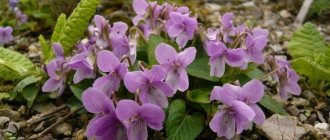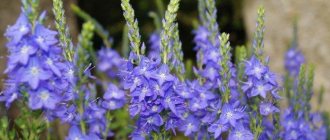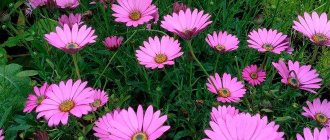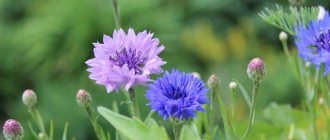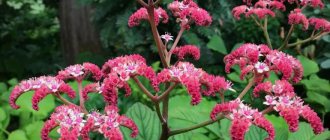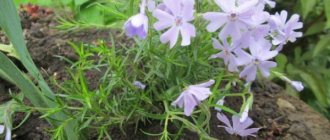general information
Amaranth is a herbaceous annual of the same family, native to South America. Many thousands of years ago, the Indians considered it the flower of immortality and brewed a miraculous drink from it. Amaranth grains are popular all over the world even now.
Amaranth inflorescences are sometimes called cock's comb or fox's tail for their characteristic shape and color. They are equally good at any time of the year, fresh or dry. A large panicle is collected from soft dense spikelets of burgundy, purple or yellow color. It is almost impossible to visually isolate individual flowers.
Amaranth blooms in early summer and continues to bloom until frost. It has large matte green or burgundy leaves with raised veins. Amaranth is a tall and dense plant up to 1.5, and sometimes up to 3 m.
Photo: 2sotki.ru
Types of amaranth
There are many types of amaranth, and they are grown for completely different purposes. There are forage, vegetable and ornamental crops, and there are also ordinary wild weeds.
Vegetable amaranth
This species quickly and actively grows abundant foliage. It is edible along with shoots and grains. Vegetable amaranth is considered the most useful among its relatives.
Photo: kartoska.ru
Yellow amaranth
A compact decorative variety with a height of only 70 cm. One bush can have leaf blades of different shades of green, orange, yellow and bronze. The inflorescences are also yellow.
Photo: floweryvale.ru
Tricolor amaranth
This amazing species belongs to the decorative deciduous species. Each leaf is painted in several colors at once - green, yellow-orange and crimson. Its inflorescences are also large, bright yellow-red.
Photo: kartoska.ru
Tailed amaranth
A beautiful ornamental annual with large pendulous clusters that last until October. The varieties whose shoots are purple are very impressive.
Photo: 2sotki.ru
Dark amaranth
A tall, low-branching species up to 1.5 m tall with decorative erect inflorescences. Both the flowers and pointed leaves have a striking purple hue.
Photo: amaranth-ukr.com.ua
Upturned amaranth
This more compact and less branched species reaches an average height of 1 m. It has green inflorescences, a very powerful tap root, fleecy shoots and large ovoid leaves up to 14 cm in length.
Photo: 2sotki.ru
Paniculate amaranth
It is simply red, with red elongated inflorescences, which can be straight or drooping. It has very powerful, strong shoots up to 1.5 m tall.
Photo: zen.yandex.ru
Monarda (50 photos): types, planting and care in open ground
What do the seeds look like?
Many people do not know what amaranth seeds look like. In fact, it is not difficult to distinguish the grains of this crop from other plants. Amaranth planting material is very small. Light varieties of plants with green leaves have sand-colored seeds (like white sesame, only much smaller), with dense, smooth, slightly shiny shells. Such varieties are used for food and feed purposes. Plants with red leaves are ornamental varieties grown for their beautiful flowers. They have black seeds, also very small. Before planting amaranth seeds, it is recommended for convenience to mix the grains with sawdust, wood ash or sand in a ratio of 1:20.
The seeds ripen well when placed on inflorescences in a dark place.
The growing season of amaranth is 70 days, and the seeds are formed after 3 months of cultivation. The grains do not ripen at the same time, so it is easier to cut off entire amaranth inflorescences, otherwise some will simply end up on the ground.
When the panicles turn brown and dry well after about a month or two, you need to remove the seeds. They need to be dried only in a dark place.
You can simply clean them in the wind or on a very fine sieve. When stored in a dry place, amaranth seeds retain the ability to germinate for five years.
Amaranth care
The correct choice of soil is one of the main conditions for keeping amaranth. Otherwise, it causes no more problems than any other garden annual!
Temperature and lighting
Amaranth is very unpretentious and can withstand almost any temperature. As a southern resident, he was accustomed to the heat and scorching rays of the sun. But the culture adapts well to cold snaps down to 0 degrees.
Photo: vk.com
Watering
Mature amaranth does not need additional watering at normal times. Water it only when the soil dries out, if the rainless season has been prolonged. But young plants, especially during the rooting period, need to be watered frequently and abundantly.
Photo: domashniecvety.ru
The soil
The soil should be moderately moist and not acidic, because this promotes the development of root rot. Choose areas with loose and nutritious soil, and add a little lime before planting.
Photo: etsy.com
Fertilizers and fertilizing
Amaranth is fed approximately 3-4 times in the evening, when the heat subsides. You can use an ordinary mullein solution, which is even better than mineral mixtures. Nitrogen fertilizers are applied for the first time when the seedlings grow to 20 cm. But reduce the recommended concentration by half.
Photo: flo.discus-club.ru
Calendula (50 photos): types, planting and care in open ground
Planting and propagation
Amaranth can be planted with seeds directly into the ground, starting at the end of April. Planting of seedlings is carried out earlier - at the end of March, and the seedlings in this case are transplanted into the garden in the second half of May.
Seeds are planted in furrows to a depth of 1.5 cm one at a time, with a distance of about 45 cm between rows and 10 cm between seeds. It is better to spend time on sowing once than to deal with planting seedlings later. The taproot rhizome does not like transplantation and unnecessary disturbances. Shoots appear within 1-1.5 weeks.
Seedlings are planted in containers according to the same principle and left in a warm, bright place. For watering, use a sprayer and maintain the temperature at 20-22 degrees. In a week, expect shoots. When the first leaves appear, remove the weakest seedlings and plant the rest in peat pots.
Photo: steklotorgopt.ru
Landing in the ground
The seedlings will be ready for transfer to open ground in about a month. If you calculate the timing correctly, by this time the weather should be consistently warm. Before transplanting, for which it is best to choose a cloudy day, they need to be well watered, this will minimize damage to the root system. On sunny days, it is better to plant amaranth seedlings in the ground in the evening, and lightly shade them the next day. Shiritsa seedlings should be placed in the hole, reclining, digging in drops above the root collar to the very first leaf.
Planting scheme
The general averaged pattern in the “square-cluster” method is 30x50cm, when planted in rows - 20x80cm. With a denser arrangement of seedlings, they begin to stretch and become brittle. The schemes also differ depending on the purpose of the crop.
- Vegetable varieties - 25x70cm.
- Cereals - 60x70cm.
- Decorative - 50x70cm.
Diseases and pests of amaranth
Most often, amaranth suffers from root rot, which leads to the rotting of adult plants and the fall of seedlings. This can be avoided by choosing the right site, maintaining distance between bushes and controlling humidity.
Fungal diseases that affect shoots and leaves are treated with fungicides. In addition, there are varieties with increased immunity - we advise you to pay attention to them.
The most common enemy of amaranth is the weevil and its larvae. They not only eat leaves and stems, but also contribute to the development of fungal diseases. Colonies of aphids also periodically settle in dense bushes. Inspect your plantings regularly and use insecticides as needed.
Photo: flickr.com
Statica (50 photos): types, care and planting in open ground
Beneficial features
Various parts of amaranth have found their use in cooking, medicine and cosmetology.
Usage options:
- infusions are used to treat various diseases: the genitourinary system, constipation, hemorrhoids, colic. Also, help cope with inflammation on the skin;
- seed oil will help solve problems with the digestive tract (gastritis, ulcers, colitis, cirrhosis), and will also have a beneficial effect on the circulatory system (treats varicose veins, heart attack, hypertension, inflammatory diseases of the heart and blood vessels);
- young leaves have many useful elements and vitamins; they are eaten in salads, purees and soups;
- stems and leaves are used as an aromatic seasoning in various dishes;
- leaves and seeds are brewed as tea, added to compotes and fruit drinks;
- toasted seeds are used in baking and confectionery: sprinkled on buns, added to cakes and cream;
- crushed seeds are used to prepare porridge;
- Seed flour is added to doughs and sauces.
Important! Amaranth is contraindicated for people who have allergic reactions to this product. Most often it manifests itself in the form of nausea, dizziness and laryngeal swelling. In some cases, indigestion may occur.
Amaranth – photo
In our latitudes, amaranth is just gaining mass popularity, so, most likely, you have not seen it very often. In this case, be sure to take a look at our photo selection!
Photo: ecomne.ru
Photo: numerologyalexk.com
Photo: zen.yandex.ru
Photo: chudogryadka.mirtesen.ru
Photo: blog.leto-shop.ru
Photo: 2sotki.ru
Photo: serviceyards.com
Photo: artfile.ru
Photo: greeninhouse.ru
Photo: stiralkovich.ru
Photo: 2sotki.ru
Photo: gwallsbest.com
Photo: erpstat.ru
Photo: healthy-inform.ru
Photo: 2sotki.ru
Photo: plantorama.ru
Photo: dachadecor.ru
Photo: flo.discus-club.ru
Photo: na-dache.pro
Photo: 2sotki.ru
Photo: fi.pinterest.com
Photo: bober-medcentr.ru
Photo: sovocrim.ru
Photo: evgenyart.livejournal.com
Photo: amaranth-health.com
Did you like the post? Subscribe to our channel in Yandex.Zen, it really helps us in our development!

